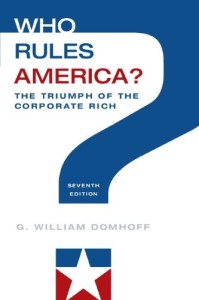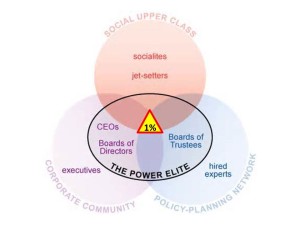
WHO RULES AMERICA? The Class-Domination Theory of Power
G. William Dornhoff
NOTE: WhoRulesAmerica.net is largely based on my book, Who Rules America?, first published in 1967 and now in its 7th edition. This on-line document is presented as a summary of some of the main ideas in that book.
Who has predominant power in the United States? The short answer, from 1776 to the present, is: Those who have the money — or more specifically, who own income-producing land and businesses — have the power. George Washington was one of the biggest landowners of his day; presidents in the late 19th century were close to the railroad interests; for the Bush family, it was oil and other natural resources, agribusiness, and finance. In this day and age, this means that banks, corporations, agribusinesses, and big real estate developers, working separately on most policy issues, but in combination on important general issues — such as taxes, opposition to labor unions, and trade agreements with other countries — set the rules within which policy battles are waged.

Contents
• Power and Power Indicators
• The Social Upper Class
• The Corporate Community
• How Government Policy Is Shaped From Outside Government
• The Power Elite
• The Power Elite and Government
• Why Business Leaders Feel Powerless
• The Weaknesses of the Working Class
• Community Power
The Weaknesses of the Working Class & Community Power Below the Line
The Weaknesses of the Working Class
There are many democratic countries where the working class — defined as all those white-collar and blue-collar workers who earn a salary or a wage — has more power than it does in the United States. This power is achieved primarily through labor unions and political parties. It is reflected in more egalitarian wealth and income distributions, a more equitable tax structure, better public health services, subsidized housing, and higher old-age and unemployment benefits.
How is it possible that the American working class could be relatively powerless in a country that prides itself on its long-standing history of pluralism and elections? There are several interacting historical factors. First, the “primary producers” in the United States, those who work with their hands in factories and fields, were more seriously divided among themselves until the 1930s than in most other countries. The deepest and most important of these divisions was between whites and African-Americans. In the beginning, of course, the African-Americans had no social power because of their enslavement, which meant that there was no way to organize workers in the South. But even after African-Americans gained their freedom, prejudices in the white working class kept the two groups apart.
This black/white split in the working class was reinforced by later conflicts between craft workers — also called “skilled” workers — and industrial workers — also called mass-production or “unskilled” workers. Craft workers usually tried to keep their wages high by excluding industrial workers. Their sense of superiority as skilled workers was reinforced by the fact that they were of Northern European, Protestant origins and the industrial workers tended to be Catholics and Jews from Eastern and Southern Europe. Some African-Americans were also found in the ranks of the industrial workers, along with other racial minorities.
It would have been difficult enough to overcome these divisions even if workers had been able to develop their own political party, but they were unable to develop such a party because the electoral system greatly disadvantages third parties. Workers were stuck. They had no place to go but the Republicans or Democrats. In the late 19th and early 20th centuries the craft workers often supported the Democrats, while the recent immigrant industrial workers tended to support the Republicans. Even when craft and industrial workers moved into the Democratic Party en masse in the 1930s, they couldn't control the party because of the power of the wealthy Southern planters and merchants.
Nor did the workers have much luck organizing themselves through unions. The employers were able to call upon the government to crush organizing drives and strikes through both court injunctions and police arrests. This was not only because employers had great influence with politicians then, just as they do now, but because the American tradition of law, based in laissez faire (free market) liberalism, was so fiercely opposed to any “restraint of trade” or “interference” with private property. It was not until the 1930s that the liberal-labor coalition was able to pass legislation guaranteeing workers the right to join unions and engage in collective bargaining. Even this advance was only possible by excluding the Southern workforce — i.e., agricultural and seasonal labor — from the purview of the legislation. Further, the passage of the legislation had only limited impact because the industrial unions were defeated almost completely in the South and Southwest. Unions thrived in a few major industries in the North in the years after World War II, but then their power was eroded beginning in the 1970s as the big corporations moved their factories to other countries or lost market share to European and Japanese companies.
Given this history of internal division, political frustration, and union defeat, it is not surprising the American workers continue to accept the highly individualistic ideology that has characterized the United States since its founding. This acceptance in turn makes it even more difficult to organize workers around “bread-and-butter” issues. They often vote instead on the basis of social issues or religious convictions, with those who are deeply religious, opposed to affirmative action, or opposed to gun control voting for the avowedly anti-union Republican Party.
Thus, it is important not to confuse freedom with social power. Between 1962 and the 1990s there was a great expansion in individual rights due to the civil rights, feminist, and lesbian-gay movements, but during that time the ratio of a top business executive's pay to a factory worker's pay increased from 41 to 1 to about 300 to 1. American workers can say what they want and do what they want within very broad limits, and their children can study hard in school so they can go to graduate school and join the well-off professional class as doctors, lawyers, architects, or engineers, but when it comes to social power most Americans have very little of it if they are not a part of the power elite.
Community Power
Not all power is wielded at the national level. For more on local power, click here.
Conclusion
The argument over the structure and distribution of power in the United States has been going on within academia since the 1950s. It has generated a large number of empirical studies, many of which have been drawn upon here. In the final analysis, however, scholars' conclusions about the American power structure depend upon their beliefs concerning power indicators, which are a product of their “philosophy of science.” That sounds strange, I realize, but if “who benefits?” and “who sits?” are seen as valid power indicators, on the assumption that “power” is an underlying social trait that can be indexed by a variety of imperfect indicators, then the kind of evidence briefly outlined here will be seen as a very strong case for the dominant role of the power elite in the federal government.
If “who wins?” on a wide range of government decisions is seen as the only valid indicator of power, and if it is expected that the power elite must win every time, which is the stance adopted by pluralist theorists on the basis of a “strict positivist” view of how power must be measured, then the argument presented here, based on a “soft positivism,” will be seen as less impressive. That's because those relatively few of us who disagree with the pluralists have not yet had the time and the resources to do enough case studies within the framework of the special-interest and policy-planning processes to show the full range of power elite dominance on policy issues. A good start has been made in this direction, but it will take more to convince the skeptics.
Also see:
Video of his fast lecture/overview regarding the question “who rules America?”



